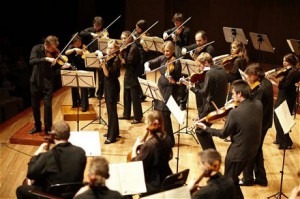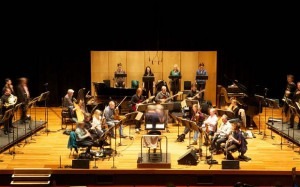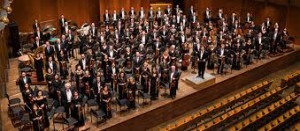
Australian Chamber Orchestra
In many cities, there are multiple orchestras and although we might think that they differentiate themselves solely through their labels: London Philharmonic and London Symphony Orchestra, etc., they may also carry other names that differentiate them by size. The smallest orchestra is the “chamber orchestra.” It is made up of up to 50 members in total. The next size up is the “sinfonietta,” which has up to around 75 members. A full “symphony” or “philharmonic” orchestra has from 80 to 100 musicians. “Symphony” comes from the Latin meaning “concert” and “Philharmonic” comes from the Greek meaning “music loving.”
Frederick Delius: 2 Aquarelles: No. 1. Lento, ma non troppo (English Chamber Orchestra; Julius Lloyd-Webber, cond.)
The membership of the three different kinds of orchestras are the same: strings, winds, percussion. On any given night, however, depending on the demands of the music, even a symphony orchestra might appear in a smaller form. Far fewer musicians are needed for a Haydn symphony than for one of the great 19th century masterworks. What’s different is the kind of music that they play.
Jean Sibelius: Suite champêtre, Op. 98b: III. Danse (Tapiola Sinfonietta, Tuomas Ollila-Hannikainen, cond.)

London Sinfonietta
All sizes of orchestra can play the music of the Classical / early Romantic era – the forces called for are within the capabilities of even a chamber orchestra. By the time we get to Mahler, however, only a symphony orchestra could tackle his largest work. Mahler’s Symphony No. 8, nicknamed the “Symphony of a Thousand,” requires an extended string section, extended woodwind and brass sections, extra percussion, an organ, 7 solo singers, chorus, children’s chorus, and a separate group made up of 4 trumpets, 3 trombones, harmonium and mandolin. There are parts for 2 harps but Mahler preferred to have 4 harps. It really doesn’t require a thousand players, but it is possible to do a performance, in a very large space, with a thousand. This is clearly impossible for a chamber orchestra to tackle.
Gustav Mahler: Symphony No. 8 in E-Flat Major, “Symphony of a Thousand” – Part I, Veni, creator spiritus: Veni, creator spiritus (Mimi Coertse, soprano; Hilde Zadek, soprano; Lucretia West, alto; Ira Malaniuk, alto; Giuseppe Zampieri, tenor; Hermann Prey, baritone; Otto Edelmann, bass; Konzertvereinigung Wiener Staatsopernchor; Wiener Singverein; Vienna Boys Choir; Vienna Philharmonic Orchestra; Dimitri Mitropoulos, cond.)

New York Philharmonic
Chamber orchestras, on the other hand, are very well suited for smaller works where the emphasis is not on the power and might of the orchestra but on the interplay of lines and the delicate changes in timbre. In a piano concerto, for instance, the pianist can have a different relationship with a chamber orchestra: instead of it being piano versus orchestra, each can take up its own idiomatic line and create a work that’s more delicate. Often when you have a piano concerto performed with a symphony orchestra, a lot of effort is made by the pianist to carve its own audio niche out of the massive orchestral sound.
If you are in a city that has multiple sizes of orchestra, revel in the differences in their sound and the music they play. Each will cause you to hear the music differently and even to hear different music.
For more of the best in classical music, sign up to our E-Newsletter




